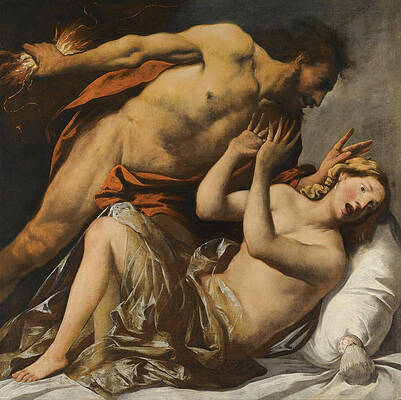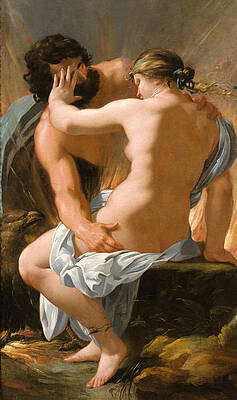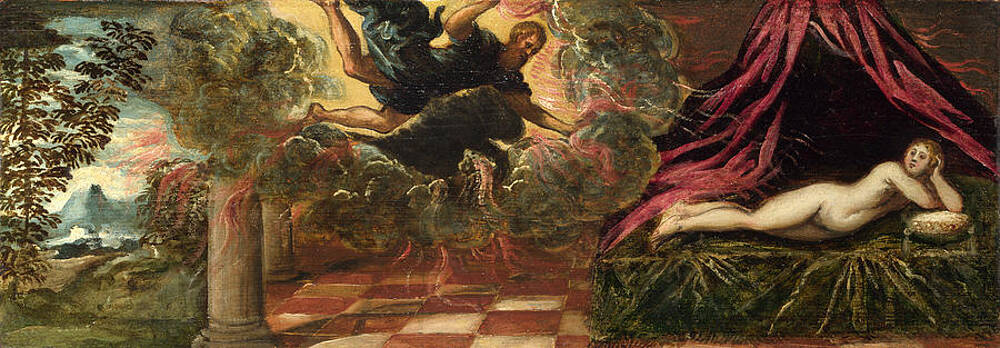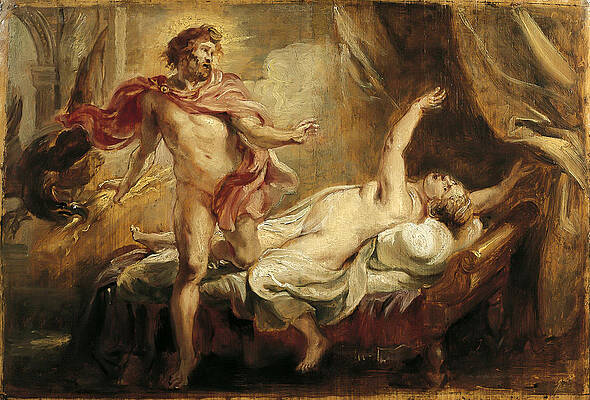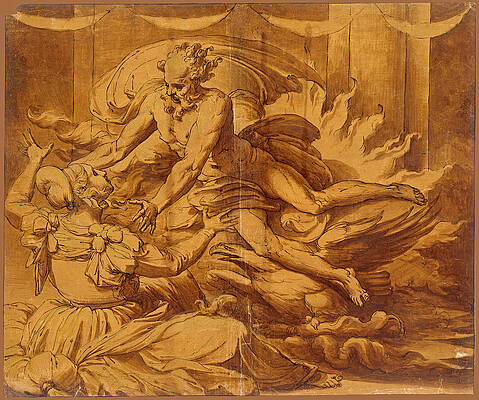
Semele, John McKirdy Duncan (1866-1945)
In Greek mythology, Semele, daughter of Cadmus and Harmonia, was the mother of Dionysus (the god and his votaries were both identified as "Bacchus") by Zeus. The name Semele, like other elements of Dionysiac cult (thyrsus, dithyramb) are manifestly not Greek (Burkert 1985), apparently Phrygian (Kerenyi 1976 p107) and the myth of her father Cadmus gives him a Phoenician origin.
Zeus's consort, Hera, a goddess jealous of usurpers, discovered the affair when Semele was pregnant. Appearing as an old crone, Hera befriended Semele, who confided in her that her husband was actually Zeus. Hera pretended not to believe her, and planted seeds of doubt in Semele's mind. Curious, Semele demanded of Zeus that he reveal himself in all his glory as proof of his godhood. Though Zeus begged her not to ask this, she persisted and he agreed. Mortals, however, cannot look upon a god without dying, and she perished (Ovid, Metamorphoses III.308-312; Hyginus, Fabulae 179).
Zeus rescued the fetal Dionysus, however, by sewing him into his leg (the "Insewn" of the Homeric Hymn). A few months later, Dionysus was born. This leads to his being called "the twice-born".
When he grew up, Dionysus rescued his mother from Hades, and she became a goddess on Mount Olympus, with the new name Thyone.[1] (http://www.theoi.com/Kronos/Thyone.html)
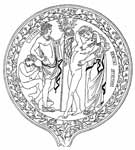
The setting for the story of Semele is the palace that occupied the acropolis of Thebes, called the Cadmeia. When Pausanias visited Thebes in the 2nd century AD, he was shown the very bridal chamber where Zeus visited her and begat Dionysus. Since a seal inscription found at the palace can be dated 14th-13th centuries BC, (Kerenyi 1976 p 198) the myth of Semele is Mycenaean in origin, pre-Hellenic.
Though the Greek myth of Semele was localized in Thebes, the fragmentary Homeric Hymn to Dionysus makes the place where Zeus gave a second birth to the god distant, and mythically vague:
"For some say, at Dracanum; and some, on windy Icarus; and some, in Naxos, O Heaven-born, Insewn; and others by the deep-eddying river Alpheus that pregnant Semele bare you to Zeus the thunder-lover. And others yet, lord, say you were born in Thebes; but all these lie. The Father of men and gods gave you birth remote from men and secretly from white-armed Hera. There is a certain Nysa, a mountain most high and richly grown with woods, far off in Phoenice, near the streams of Aegyptus..."
The story formed the basis for the secular oratorio, Semele (1744) by George Frideric Handel and for the opera, Semele (1707) by John Eccles.
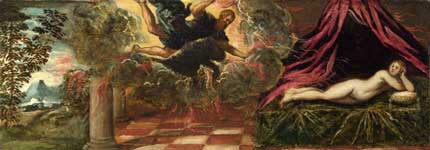
Jupiter and Semele, Tintoretto
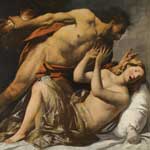
Jupiter and Semele, Pietro della Vecchia
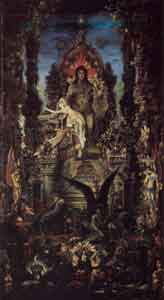
Jupiter and Semele, Gustave Moreau

Jupiter and Semele, Pietro della Vecchia
Jupiter and Semele, Dosso Dossi
Jupiter and Semele, Francois Perrier
Jupiter and Semele, Tintoretto
Death of Semele, Peter Paul Rubens
Jupiter Appearing to Semele, Perino del Vaga
Images
Dionysos and his mother Semele
Sources
- Apollodorus, Library (3, 4, 2) ;
- Euripides, Bacchae (II, 242) ;
- Herodotus, Histories (II, 145).
Reference
Greek Religion, Walter Burkert
The Greek Myths: The Complete And Definitive Edition, Robert Graves
Dionysos: Archetypal Image of Indestructible Life, Carl Kerenyi
Gods of the Greeks, Carl Kerenyi
The Homeric Hymns, 2nd Edition, Apostolos N. Athanassakis
Seltman, Charles, 1956. The Twelve Olympians and their Guests. Shenval Press Ltd
See also : Greek Mythology. Paintings, Drawings
Greek Mythology Index
A - B - C - D - E - F - G - H - I - J - K - L - M -
N - O - P - Q - R - S - T - U - V - W - X - Y - Z
Α - Β - Γ - Δ - Ε - Ζ - Η - Θ - Ι - Κ - Λ - Μ -
Ν - Ξ - Ο - Π - Ρ - Σ - Τ - Υ - Φ - Χ - Ψ - Ω
Retrieved from "http://en.wikipedia.org/"
All text is available under the terms of the GNU Free Documentation License
| Ancient Greece
Science, Technology , Medicine , Warfare, , Biographies , Life , Cities/Places/Maps , Arts , Literature , Philosophy ,Olympics, Mythology , History , Images Medieval Greece / Byzantine Empire Science, Technology, Arts, , Warfare , Literature, Biographies, Icons, History Modern Greece Cities, Islands, Regions, Fauna/Flora ,Biographies , History , Warfare, Science/Technology, Literature, Music , Arts , Film/Actors , Sport , Fashion --- |

